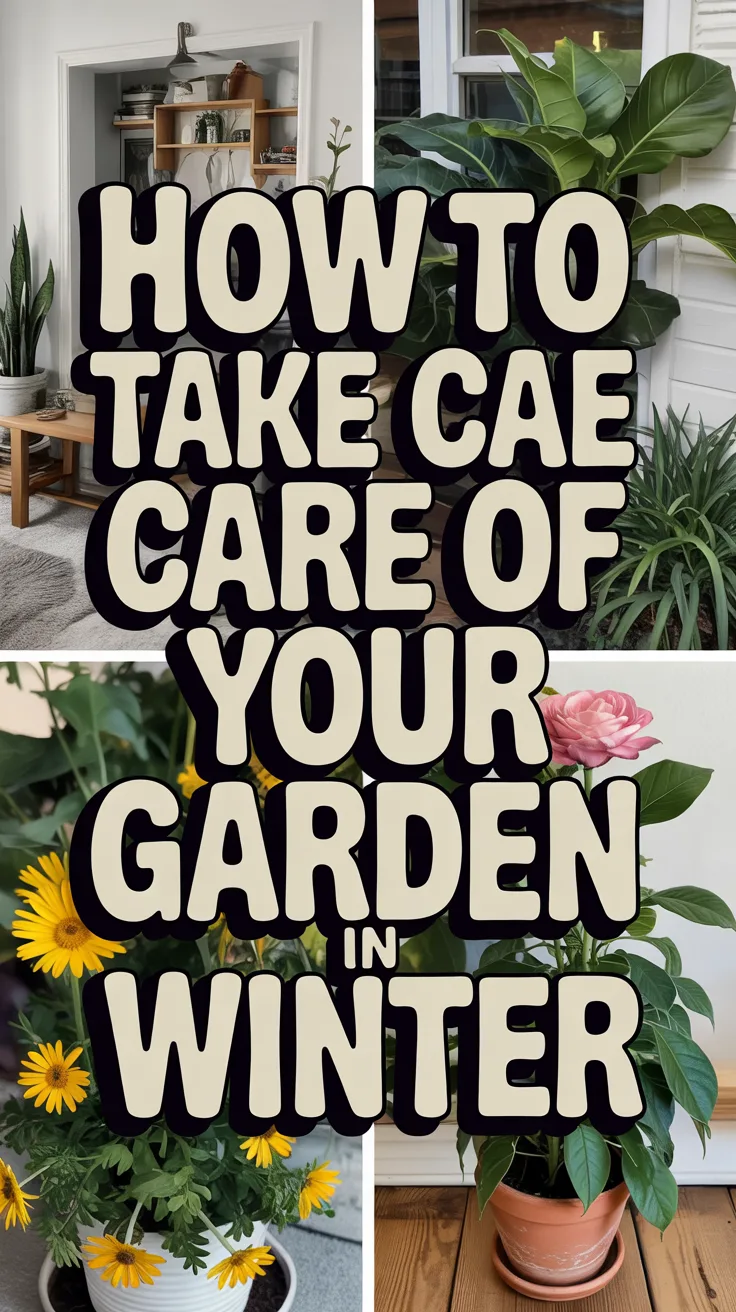Imagine stepping out into your backyard on a crisp autumn morning, leaves crunching underfoot, and realizing winter’s chill is just around the corner. Your vibrant summer blooms and thriving veggie patch suddenly feel vulnerable—will that unexpected frost wipe out your prized roses or stunt your perennials? If you’re wondering how to take care of your garden in winter, you’re not alone. Many gardeners face this seasonal shift with a mix of excitement for cozy indoor days and anxiety over plant survival.
Winter garden care isn’t just about survival; it’s the secret to a lush, bountiful spring. By protecting your plants from the cold, nurturing your soil, and planning ahead, you ensure your garden bounces back stronger than ever. This comprehensive guide covers everything from frost protection techniques to soil maintenance tips, making it your one-stop resource for winter garden maintenance. Whether you’re a newbie eyeing your first flowerbed or a seasoned green thumb tweaking advanced strategies, we’ll walk you through actionable steps tailored to your needs. Let’s dive in and turn winter worries into winter wins.
How to Take Care of Your Garden in Winter: Essential Steps
Getting a handle on how to take care of your garden in winter starts with a simple checklist of must-do tasks. Think of it as tucking your garden in for a long nap—cozy, protected, and ready to wake up refreshed. These essential steps form the backbone of winter prep, preventing damage from freezes, wind, and heavy snow while setting the stage for spring growth.
First, assess your garden’s hardiness zone—those USDA maps that divide the U.S. into climate bands based on average winter lows. (If you’re new to this, it’s like a weather report card for your plants; find yours online for free.) Tailor your efforts to mild winters in zones 8-10 versus harsh ones in 3-5. Next, clear debris like fallen leaves to curb pests and diseases—compost what you can for eco-friendly recycling.
Here’s a quick-start numbered list to kick off your winter routine:
- Inspect and Clean: Walk your garden, noting vulnerable spots. Remove dead foliage to avoid rot.
- Water Wisely: Give plants a deep drink before the ground freezes, as dry roots crack in cold.
- Monitor Weather: Use apps to track forecasts—early snow means faster action.
- Gather Supplies: Stock up on mulch, covers, and stakes affordably from recycled sources.
By following these, you’ll avoid common pitfalls like overwatering dormant plants, which can lead to root rot. Remember, not every garden sleeps entirely; evergreens and cool-season veggies keep humming, so adjust accordingly. This foundation keeps things straightforward, whether you’re in a snowy Northeast plot or a rainy Pacific Northwest yard.
How to Protect Plants from Frost: Proven Techniques
Frost can sneak up like an uninvited guest, turning lush leaves to brittle crisps overnight. How to protect plants from frost is a top concern for gardeners, especially if you’ve invested sweat equity in tender perennials or annuals. The good news? Simple, budget-friendly methods can shield your darlings without breaking the bank or harming the environment.
Start by understanding frost types: light (28-32°F) nips edges, while hard freezes below 28°F demand serious intervention. For in-ground plants, timing is key—cover them in the evening before temps drop. Beginners, think of frost covers as cozy blankets; advanced folks, layer for insulation in extreme climates.
Break it down by plant type with these H3-focused strategies:
Shielding Perennials and Shrubs
Perennials like hostas go dormant but need root protection. Wrap trunks with burlap or tree guards to prevent sunscald—those bark splits from winter sun thawing ice. For roses, mound soil 8-12 inches high around bases, then add leaves or straw. In mild areas, this suffices; in harsh zones, add a wire cage filled with loose mulch for airflow.
Safeguarding Annuals and Potted Plants
Annuals like petunias rarely survive outdoors, so dig and store bulbs in a cool garage. Potted herbs? Group them on a sheltered porch and wrap pots in bubble wrap or old towels—insulate those roots! If a freeze hits anyway, mist plants with water before nightfall; it forms an ice shield that melts slower than air temp.
Pro tip: DIY cloches from gallon jugs (cut off bottoms) trap warmth for small veggies. And bust the myth—covering everything isn’t necessary; hardy natives like coneflowers laugh at light frost. Relate it to your life: Just as you’d layer up for a chilly walk, your garden appreciates that extra hug.
Winter Garden Maintenance Tips: Mulching Mastery
Mulching is the unsung hero of winter garden maintenance tips, acting like a warm quilt for your soil. It locks in moisture, suppresses weeds, and regulates temperature swings that heave roots. Skip it, and you risk cracked earth come thaw; do it right, and your beds stay fertile.
Choose materials wisely—organic like shredded bark or straw breaks down into nutrients, while inorganic like gravel suits paths. Aim for 2-4 inches deep, but keep it away from stems to dodge rot. For beginners: Mulch is just chopped-up plant matter; pros, match types to soil—coarse for clay to improve drainage, fine for sand to retain water.
Apply in late fall after the first frost hardens soil, preventing early warm spells from fooling bulbs into sprouting. In rainy regions, use less to avoid sogginess; snowy areas, pile higher for insulation. Imagine your tulips pushing through unscathed next spring— that’s the magic of mulch done right.
| Mulch Type | Best For | Pros | Cons |
|---|---|---|---|
| Straw | Veggie beds | Affordable, easy to spread | Breaks down fast, attracts rodents if not monitored |
| Bark Chips | Trees & shrubs | Long-lasting, attractive | Slower to decompose, can tie up nitrogen initially |
| Leaves | Flower beds | Free from yard waste, enriches soil | Mats down if wet; shred for even coverage |
| Pine Needles | Acid-lovers (e.g., blueberries) | Good drainage, natural pest deterrent | Acidifies soil—test pH first |
This table helps compare options quickly. Eco-twist: Rake your own leaves for zero-waste wins.
Pruning and Plant Maintenance in Winter: Timing It Right
Winter pruning feels counterintuitive—like giving your garden a trim while it’s “asleep”—but it’s prime time for shaping without disease spread. Done correctly, it promotes vigorous spring growth; botched, it invites stress. Focus on dormant deciduous trees and shrubs, avoiding evergreens unless deadwood calls.
Use sharp, clean tools to make angled cuts just above buds. For fruit trees, remove crossing branches to open the canopy—think airflow as your garden’s natural AC. Beginners: Pruning is selective snipping to encourage health; experts, consider hardiness—zone 6 apples need lighter touch than zone 9 figs.
Seasonal nuance: Early winter for cleanup, late for shaping. In mild climates, extend into January; harsh ones, wait till mid-February to dodge deep freezes. Scenario: Picture your hydrangeas blooming bigger because you nixed those weak stems now. Myth busted: Not all plants need winter cuts—over-pruning evergreens can shock them.
Actionable steps:
- Sanitize pruners with alcohol between plants.
- Mulch pruned bases for extra protection.
- Compost healthy trimmings; burn diseased ones.
This maintenance keeps your garden tidy and thriving.
Winter Care for Vegetable Gardens: Cool-Season Strategies
Winter care for vegetable gardens shifts from harvest hustle to hardy holdouts. While tomatoes tuck in, kale and carrots strut their stuff in the cold. Proper prep means fewer pests overwintering and soil primed for March sowings.
Harvest remaining crops before ground freezes, then till lightly to aerate—don’t overdo it, as it disturbs microbes. Plant cover crops like clover to fix nitrogen naturally. For ongoing yields, sow cold-tolerant stars: spinach thrives under row covers, garlic planted now bulbs up by summer.
Regional tweaks: Mild South? Extend lettuce beds with hoop houses from PVC and plastic. Northern chills? Deep mulch brassicas like broccoli. Beginners, row covers are fabric drapes for warmth; pros, vent them on sunny days to prevent mold.
Troubleshoot: If voles tunnel under mulch, use hardware cloth barriers. Relatable: That homegrown winter salad? It’s your reward for fall foresight. Emphasize budget hacks like seed-saving for next year’s starters.
Winterizing Garden Tools and Equipment: Longevity Hacks
Your tools deserve TLC too—rusty shears or cracked hoses spell spring frustration. Winterizing them extends life, saving cash on replacements. It’s like oiling a bike before storage: simple prevention beats costly fixes.
Clean everything post-season: Hose off dirt, sharpen blades with a file. Oil moving parts with WD-40 or veggie oil for rust block. Store in a dry shed—hang shovels to avoid flat edges.
For advanced: Disassemble mowers, drain fuel to prevent gumming. In humid spots, silica packs absorb moisture. Myth: “They’ll be fine outside”—nope, freezes crack handles.
Quick list:
- Wipe down with soapy water.
- Lubricate joints.
- Cover or shelve indoors.
This ritual closes the gardening year on a high note.
Indoor Gardening During Winter: Bringing the Outdoors In
When Jack Frost nips, why not invite your garden inside? Indoor gardening during winter keeps green thumbs busy and counters cabin fever with fresh herbs on your windowsill. It’s beginner-friendly therapy—pots of basil beat bland store buys.
Start small: Succulents or pothos forgive low light; LEDs boost basements. Overwinter tender plants like citrus by pruning and potting in well-draining soil. Water less—overwatering mimics monsoon woes.
Eco-tip: Reuse yogurt cups as pots, drill drainage holes. For climates without sun, mist for humidity. Scenario: Sipping tea by your thriving fern, dreaming of outdoor replanting. Advanced: Hydroponics for year-round veggies, but stick to soil for starters.
This bridge keeps momentum till thaw.
Preparing Your Garden for Winter: Planning for Spring Success
Preparing your garden for winter isn’t all defense—it’s offense for spring. Use downtime to map beds, order seeds, and amend soil. It’s your blueprint for blooms that wow.
Sketch layouts: Rotate crops to foil soil depletion. Test pH with kits—aim neutral for most. Stock frost-resistant picks like pansies for early color.
Late winter tasks: Prune as buds swell, divide perennials. In mild areas, direct-sow peas by Valentine’s. Positive spin: Your journaled notes turn “what if” into “watch this.”
Action: Review last year’s hits—more zinnias? Less finicky impatiens? This foresight makes spring seamless.
Best Practices for Winter Garden Soil Care: Nourish from Below
Soil is your garden’s unsung foundation—neglect it in winter, and spring struggles ensue. Best practices for winter garden soil care focus on building resilience against erosion and nutrient loss. Healthy dirt means robust plants, period.
After cleanup, add compost or manure—let it mellow till planting. Avoid tilling frozen ground; it compacts instead. Cover bare spots with cardboard and mulch to smother weeds passively.
For specifics: Sandy soils need more organic matter for retention; clay benefits from gypsum for drainage. Test every few years—kits are cheap. Myth: All soil’s the same—nope, regional tweaks matter, like lime for acidic East Coast plots.
Steps:
- Spread 1-2 inches compost.
- Water if dry, then cover.
- Monitor for compaction post-thaw.
Budget win: Kitchen scraps kickstart compost piles. Your soil thanks you with deeper roots come greening.
FAQs About Taking Care of Your Garden in Winter
How do I protect plants from frost without spending much?
Budget frost shields abound: Use old bedsheets or newspaper under buckets for cloches. For pots, group and wrap in towels. Act before sunset, remove at dawn to avoid trapping heat buildup. This DIY duo insulates effectively in mild freezes—perfect for beginners pinching pennies.
What are the best winter garden maintenance tips for beginners?
Start with cleanup and mulching—remove debris, layer 3 inches straw. Water deeply once monthly if dry. Check weekly for rodent signs. These low-effort habits build confidence, preventing overwhelm while yielding pro results.
How to take care of your garden in winter if you have a vegetable patch?
Harvest, then mulch heavily around survivors like leeks. Sow garlic cloves 2 inches deep in fall. Cover soil with black plastic in sunny spots to warm early. Rotate next season’s plan now for pest-proof yields.
Preparing your garden for winter: When should I prune?
Dormant season, post-leaf drop to pre-bud swell—November to February. Focus on dead or rubbing branches. Avoid sap-flowing maples in fall. This timing minimizes stress, maximizing spring vigor.
Winter care for vegetable gardens in mild climates?
Extend harvests with cold frames—angled glass for passive solar. Plant overwintering onions, keep soil moist but not soggy. Thin crowds to boost air flow. Mild zones let you sneak in brassicas till December.
Best practices for winter garden soil care in cold areas?
Insulate with thick mulch or straw bales. Avoid walking on frozen ground to prevent ruts. Add lime if pH dips below 6.0 for nutrient unlock. These shield microbes, ensuring fertile thaws.
Can I do indoor gardening during winter for all plants?
Not all—tropicals like monstera yes, but deep-rooted trees no. Choose pots under 12 inches for ease. Fertilize sparingly, half-strength monthly. It bridges seasons beautifully for herbs and flowers.
Wrapping Up: Your Garden’s Winter Glow-Up Awaits
There you have it—your roadmap for how to take care of your garden in winter, from frost-fighting wraps to soil-nurturing mulches and spring scheming. Key takeaways? Protect vulnerables early, maintain tools and dirt diligently, and embrace indoor escapes for continuity. These steps, whether basic covers or advanced rotations, ensure a resilient plot that explodes with life next season.
Don’t let the cold sideline your passion—grab those gloves and start today. Your future self (and those envy-worthy blooms) will thank you. What’s your go-to winter trick? Drop it in the comments below, share this guide with a fellow gardener, or pin it for later. Here’s to a winter well-prepped and a spring spectacular!
(Word count: 2,248)



